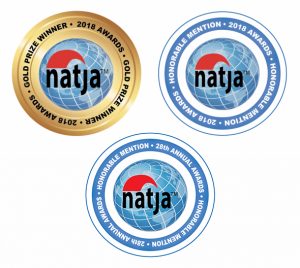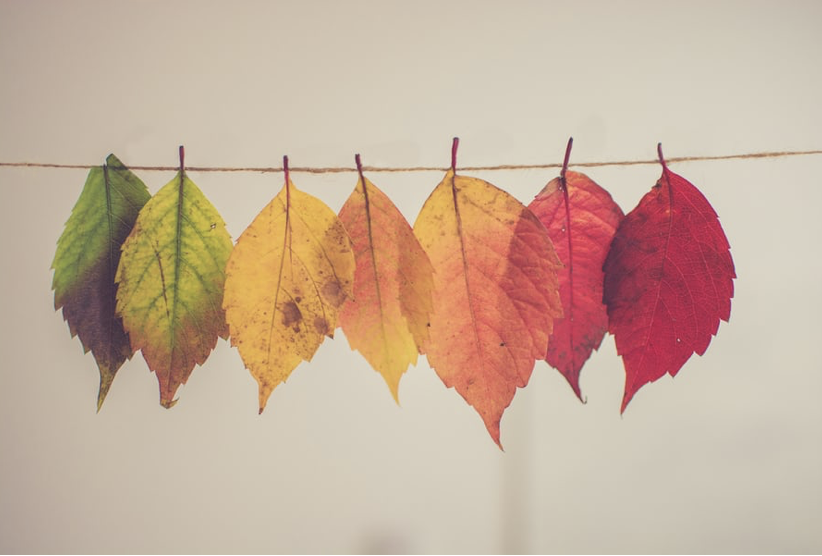
by Pat Wetzel | Nov 24, 2019 | Healing, Road Trip, The Story
Thanksgiving is a time for gratitude, especially if your life has been touched by cancer. Along those lines, let me share some recent encounters of the cancer kind.

Take a moment to share your kind thoughts with someone dealing with cancer. Become part of the project.
Cancer: Prohibited Topic
I had a most interesting conversation the other day. I was introduced to a woman who was not very enthusiastic or curious about CancerRoadTrip.
This alone is an anomaly.
The usual response is a shared cancer story, either one’s own or that of a friend.
She went on to reveal that she had had a mastectomy and it wasn’t really such a big deal.
But her doctor was excellent. She had excellent care. Her doctor, she insisted, was the best.
They didn’t get clean margins, so she had to do radiation she said. Then 5 years of estrogen restricting drugs.
It wasn’t a big deal, she insisted.
Her doctor was excellent.
Her cadence was flat. Her affect lacked depth. She was impeccably groomed. A handsome and attractive woman, 60 something I would guess.
Her response to me was so blank, I had to ask:
Do you ever worry about recurrence?
“I’m 5 years out”, she informed me, as if this magical line in the timeless sand spoke volumes that needed no explanation.
“Although they are now saying you want to be 7 years cancer free,” she added.
It really wasn’t a big deal.
My doctor was the best.
The conversation was over before it had even begun.
I’ve met people like this before. Cancer was a blip. It’s gone, never to return (fingers crossed). It’s filed away with other unpleasant thoughts, buried deep, not to be resurrected.
EVER.
NO MATTER WHAT.
I think I envy them their certainty. Their ability to disregard their brush with mortality as if it never happened. Their seeming lack of morbid imagination.
Or do I?
Is denial as good a way as any to deal with this retched disease? Is there any value in reflection, in integrating the experience into one’s life for the lessons learned and the perspective gained? And to what end does an examination of one’s scars finally lead?
Is recognition of limited time “good” or “bad”? Can a binary answer even begin to address the recognition of mortality?
For many, cancer brings a deep seated appreciation of life. Can one have this wonder of the moment without grasping its fragility? Like a photograph, the magic of light and composition is so fleeting, made of nothing but pixels of shadow.
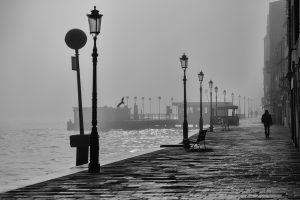
“Taking pictures is savoring life intensely every hundredth of a second.”
Marc Riboud
Walking the Cancer Walk
Another conversation, this time with a woman whose friend was dealing with bowel cancer.
“We used to walk every day,” she said.
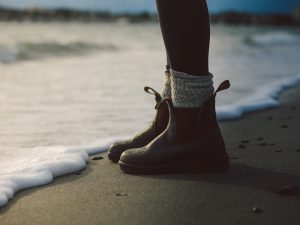
PhotoCredit: Max Conrad on Unsplash
“Now she has continence issues, so she can’t really go out for a walk anymore. I never see her.”
She went on to talk about all the ways her former friend had fallen out of her life. How she could no longer participate in even simple things.
I suggested she leave a note on the website, to be included in the film credits.
A cloud came over her. A darkness. She seemed, well, ashamed.
I wondered if this was the first time she talked about her friend and her absence from her life. If it was the first time she reflected on the loss, both for her and her former walking buddy.
My intent was not to make her feel badly, but to give her a positive way to reach out and perhaps release some of her emotion.
“I bet there’s a story behind CancerRoadTrip,” she responded after a brief pause in the conversation.
I started to tell the tale, but the speaker on the stage picked up the microphone and started introducing a panel. There was no place for conversation.
I gave her a card, thanked her for the conversation, and left.
I never heard from her. I wonder if her friend did.
“Kind words can be short and easy to speak, but their echoes are truly endless.” -Mother Teresa

Photo by Ty Williams on Unsplash
Cancer and Caregivers
Another encounter, this time with a young woman who had taken care of two relatives with cancer.
She looks so young to have shouldered such responsibility. Her smooth face belies the experiences in her soul.
What do you say to someone who finds their young life consumed by death?
The daughter of one friend started a group called The Dead Parents Society. She was a teenager when her father died of cancer and she had no peer group. Her other friends couldn’t understand the depth of the loss she had experienced.
Another young woman interrupted her life and career to take care of her mother and two younger siblings. She is now in her early thirties, working to restart her young life. Loss, anger, isolation…she’s seen it all. To cope, she is giving back through cancer advocacy groups.
The stories go on. Everyone has a story to tell because cancer has impacted all of us.
This holiday season, please take the time to reach out to someone dealing with cancer.
Just say hi, send a text, show your care. Your kind words may mean more than you’ll ever know.

Photo by Adam Solomon on Unsplash
More Reading On Gratitude and Cancer
Gratitude: A Habit for All Times
CancerRoadTrip: The Film
Labyrinth Walking In Santa Fe
Traveling With Cancer: A One Year Anniversary
Like This Post? Pin It!
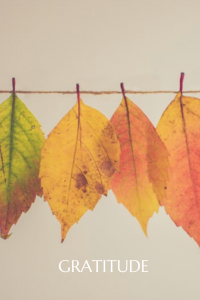
If you’re interested in learning more about photography (or cooking or film or any number of topics) check out MasterClass All-Access Pass for on-line excellence:
 [et_bloom_inline optin_id=”optin_10″]
[et_bloom_inline optin_id=”optin_10″]
What is #CancerRoadTrip and how did it come to be? Read this post to get the backstory!
Follow me on Twitter, Pinterest, Instagram, and at Anti-Cancer Club. Connect with me! I may need a place or two to stay along the way!
Follow my blog with Bloglovin
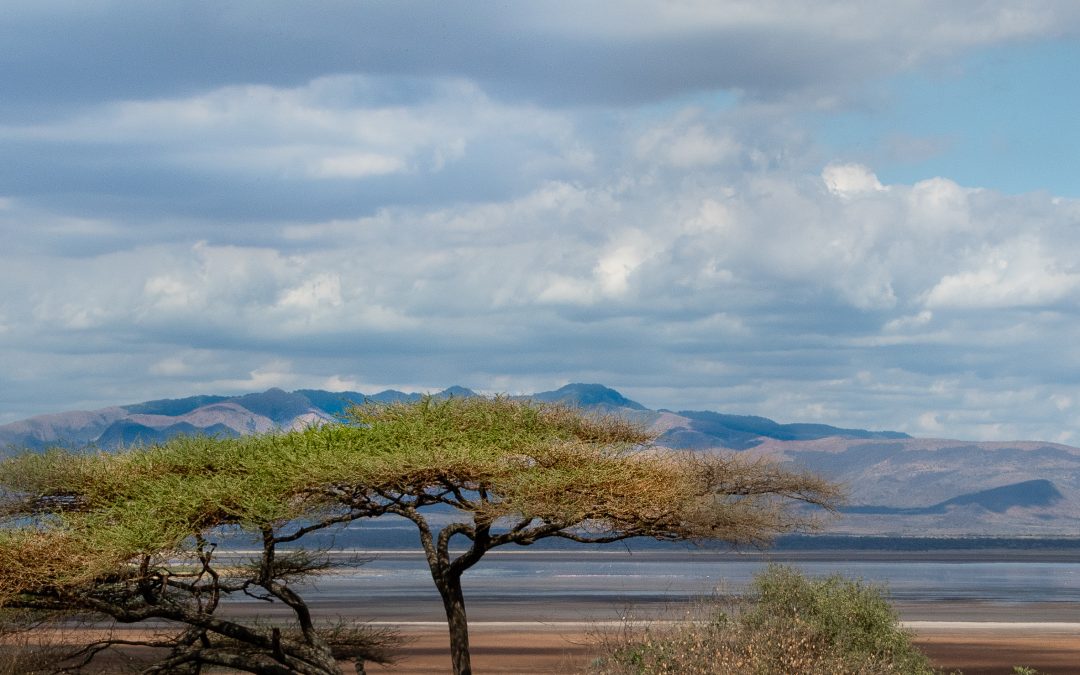
by Pat Wetzel | Nov 17, 2019 | Road Trip, The Story
Lake Manyara beckons as our Tanzania photo safari begins.
The vehicle is stocked; our camera equipment ready; and the dusty road blows by. Lake Manyara is not too long a drive. It’s just 126 km from Arusha, about an hour and a half.
This particular road is paved and passes groups of houses here and there. Don’t let this lead you to false expectations. Dusty two lane washboard roads with no amenities in sight are the norm.
We breezed through regular police checkpoints along the route, undoubtedly due to our tourist status.
And that day, on my Tanznaia photo safari, I started my habit that I called my drive-bys.
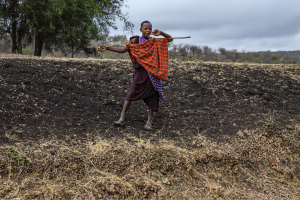
There were so many interesting people and sites along the road. But our mission was wildlife photography, not local culture. So I set my camera on a high shutter speed, and hoped I’d capture some images of life along the way.
Lake Manyara National Park is a wildlife refuge in western Tanzania and the seventh largest lake in the country. The origin of its name is uncertain. The Maasai word emanyara refers to the enclosure around a home, which is mimicked in nature by a 600 meter rift escarpment that surrounds the Lake. Or perhaps the Mbugwe word manyero which refers to a place where animals drink water is the source of the name.
Baboons, flamingos and tree climbing lions in habit the area, as well as hundreds of other species. It’s a perfect introduction to a Tanzania photo safari.

More Reading on a Tanzania Photo Safari
Kili, Culture and Connection
Photo Gallery: Elephant Love in the Serengeti
An African Photo Safari With A Nikon Ambassador
Safari Clothes: Packing for Safari
An African Photo Safari: Photo Equipment Packing List
Visas and Vaccinations for Tanzania
Like This Post? Pin It!
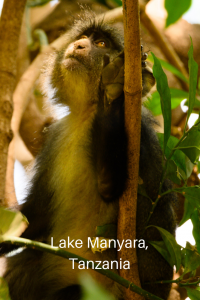
If you’re interested in learning more about photography (or cooking or film or any number of topics) check out MasterClass All-Access Pass for on-line excellence:
 [et_bloom_inline optin_id=”optin_10″]
[et_bloom_inline optin_id=”optin_10″]
What is #CancerRoadTrip and how did it come to be? Read this post to get the backstory!
Follow me on Twitter, Pinterest, Instagram, and at Anti-Cancer Club. Connect with me! I may need a place or two to stay along the way!
Follow my blog with Bloglovin
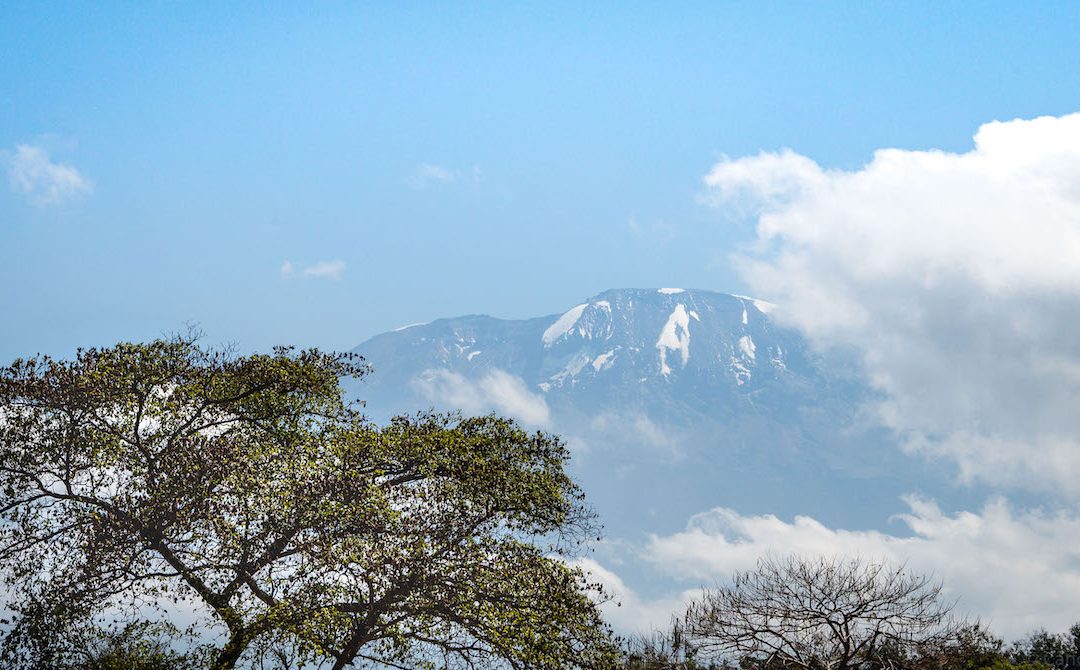
by Pat Wetzel | Nov 4, 2019 | Road Trip, The Story
Tanzania Days 2 and 3
I had another day before joining up with the other photographers in the group. On my agenda was Mt. Kilimanjaro.
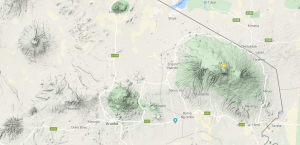
Kili is in eastern Tanzania. Our travels towards the Serengeti would take us west.
A trip to Tanzania without at least seeing Kilimanjaro (“Kili”) just wasn’t an option. Our photographic travels were taking us west and north towards the Serengeti, not east towards the renown mountain.
So with my second free day, after a hike around Lake Duluti, it was off to Kili to see it, if not climb it.
Kilimanjaro
Kilimanjaro is a legend.
Its local name depends on who you talk to. In Swahili it is “‘Mountain of Greatness” or “White Mountain” or in Maasai, “The Mountain of Water”.
Kili was first summited in 1889 by German geology professor Hans Meyer.
More recently a Swiss-Ecuadorian, Karl Egloff, set a speed record for the mountain, going up by the Umbwe route and back via Mweka in just under 7 hours.
Most people take 6 days or so just for the ascent, and about 2 days for the descent.
There are seven established routes on the mountain, each with its own pros and cons: Marangu, Machame, Lemosho, Shira, Rongai, Northern Circuit and Umbwe.
The various approaches offer different experiences, ranging from the gentler Marangu route (which also has dorm style sleeping quarters that are especially popular during the rainy season) to the steeper but popular Machame route. Some excellent information on the various routes can be found here.
My route was via the Arusha-Himo Road and safari vehicle. And back in time for a multi-course dinner served in the English inspired dining room.
My driver, “Gift” (an English translation of his Swahili name) was the same person who picked me up at the airport, and, I learned, he would be our driver for the entire trip.
There is a saying in Swahili:
“Jina jema hungara gizani”
A good name shines in the dark
And that was certainly true of Gift who became part of our safari adventure.
Becoming a safari driver requires a fair amount of training, and that training was evident in Gift. From managing sometimes difficult road conditions (and not sending us plummeting off the road near the Ngorongoro Crater like another less fortunate vehicle) to finding extraordinary wildlife, Gift was an integral part of our safari .
Gift also took care to be sure our double diesel fuel tanks were always full; the vehicle cleaned and washed every night; that the cooler was stocked with plenty of water; and he generally looked out for all of us.
We left for Kili in the morning. Heading east along the Arusha-Himo Road, I wondered if we’d even be able to see Kilimanjaro. The 20,000’+ mountain is often shrouded in clouds. But as luck would have it, the clouds broke and the mountain appeared.
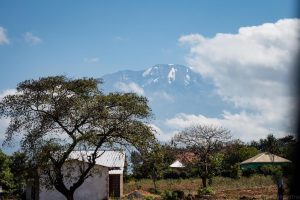
Kilimanjaro emerges from the clouds.
On the drive to Kilimanjaro, one leaves behind the dusty plains and as the altitude rises, one enters a richer, lusher climate belt. Women with huge clusters of bananas balanced atop their heads walk the road. The jungle becomes green and dense.
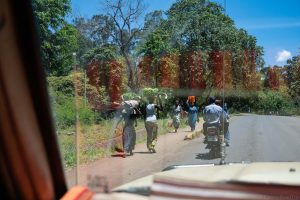
The road to Kilimanjaro taken from the safari vehicle
And then the gate to Kili appears. Groups laden with hiking gear gather, ready for a hike to the summit which can run from 5-9 days. Sherpas and other support staff are available to carry the food, tents and heavier gear for many hikers.
The sherpa assistance can be especially appreciated on the last day of the ascent. The push to the summit, everyone agrees, is tough. The brutal cold makes moving difficult, but the view from over 20,000 feet definitely compensates.
Like most national parks in Tanzania, the entry fees can be stiff. Hiking Kilimanjaro runs from $1,000 at the very low end to $4,000 and above. The government mandates a guide service plus fees of $600-700 per climber.
While the climb is not technical, it is not without risk. Every year about 1,000 people have to be evacuated and it is said that the number of deaths is under-reported. Being very fit, and having an experienced, reputable guide is essential.
The drive to Kili also offered some interesting glimpses into local culture. The photos below were taken mostly from a moving vehicle, but they give a sense of the environment and the people, from the towns and savannahs to the jungle at the base of Kilimanjaro.
[rev_slider alias=”template-Kili”][/rev_slider]
Being shepherded about by Gift, I found myself in a bit of a tourist bubble. Mingling was difficult.
Along with my fellow photographers, we stood out, by virtue of our skin color, our clothes and our own culture.
Safety was also a potential issue. On the one hand, not much intimidates me. On the other hand, wandering around alone with $15 -$20,000 of photo gear on one’s back was probably not the smartest idea here, or anywhere else for that matter.
But from my travels, a few observations.
I noticed that many of the women had beautiful, complicated hair styles, consisting of long braids gathered together, sometimes in a ponytail, sometimes in gravity defying loops. I wish I had taken photos of them. They were truly stunning.
And hair, I learned, is a significant part of the cultural heritage for the 125 ethnic groups, speaking 120 languages across modern day Tanzania.
From Africa.com on African Women’s Hairstyles:
“Hair played a significant role in the culture of ancient African civilizations. It symbolized one’s family background, social status, spirituality, tribe, and marital status.
As early as the 15th century, different tribes used hair to show one’s social hierarchy. Members of royalty wore elaborate hairstyles as a symbol of their stature…”
Hair styling was also a part of the social culture, and remains so for many tribes.
The tradition of hair in African women would also emerge during our visit to the Arusha Cultural Center. More on that below.
Out and about, I also noticed that many women carried substantial loads carefully balanced on their heads.
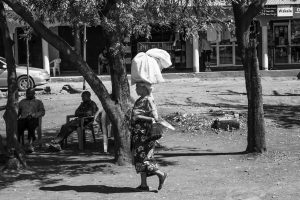
Woman walking along the roadside, Tanzania
Other cultures, like the descendants of the Tewe people in the southwest U.S., created pottery especially designed to sit atop one’s head.
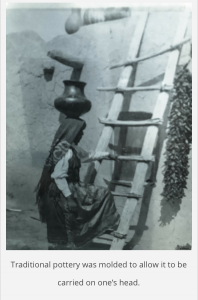
I find it curious that this tradition spans continents and centuries, tens of thousands of miles apart.
How is it that disparate cultures share so much in common?
Day 1 of the Official Safari: The Arusha Cultural Center
On Day 1 of the official safari, the group of 3 professional photographers and myself met up to visit the Arusha Cultural Center. As would become our routine for the next week and a half, Gift drove.
The Center houses all sorts of African art. Mezzanines open to a central, interior courtyard. Walkways curl up from floor to floor, with each level showcasing a different type of art. Hand carved chairs, tribal masks, painting, bronzes (old and new), and photographs were among the works presented.

Inside, the open gallery winds its way up numerous levels, all filled with African art.
And under construction is a new pavilion celebrating the work of Jane Goodall. We had just missed her by a week or so.
With or without a chance to meet Jane Goodall, the entire Cultural Center is simply amazing. The collection of masks on the lower level was, for me, totally captivating:
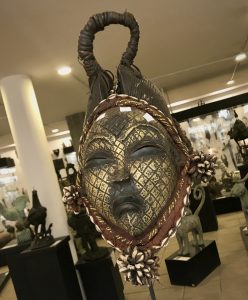
Okui mask from the Punu people of Gabon
This particular mask shows the Mmwo Sprit Maiden with an elaborate hairstyle. From the Arusha Cultural Center:
“The mask would be worn with a colorful costume covering her body. Although the mask has known as duma or mvidi, it represents a female guardian spirit in the initiation of young girls….
The refined features and elaborate coiffure of the Puno mask mirrors the appearance of tribal women. The white pigments…allude to the anti-witchcraft powers of this group. The Puno make only mask women, with elaborate hairstyles, and white kaolin pigments. They are worn by Moukouji initiates, who are often on stilts.”
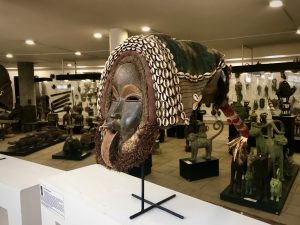
Another mask from the collection

Dan Mask High Crest Libera
From the Cultural Center:
“The Dan mask are made of various materials, included are leather, metal fabric…This Dan mask is classic in its features with slim, closed eyes and a distant expression…
The Dan believe that spirits, known as “Du”, live in the forests and manifest themselves to humans in masks and masquerades, instructing and sustaining the Dan in life.”
And the Benin Bronzes which dated from the Benin or Edo Empire (1440-1897) was produced mainly for the court of the Oba of Beni. For more than 500 years, West African artists created objects for use in divine rituals, to honor the king.
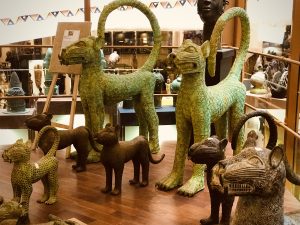
Benin bronzes were crafted to honor the king

Close up of feline bronzes at the Arusha Cultural Center
More contemporary bronzes reflect the natural world:
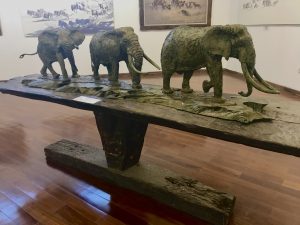
Elephants in bronze atop a wooden table
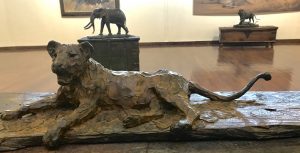
Lioness Sitting, by Mike Ghaui
In addition to the art, some of which is for sale, a small village of shops offers African spices, gems and wares. Rather than shopping, I settled in for yet another amazing cup of coffee, a Zanzibar coffee filled with cardamon, cinnamon and spice.
Beans, Rice and Photography
In addition to Kilimanjaro and the Cultural Center, a visit to the cash machine for some local currency (shillings) was in order.
And I was on a quest for rice or beans.
Not to eat, but to fill my bean bag.
A photographic bean bag is a vital piece of equipment for a safari. It’s a small or large bag, filled with something like beans or rice, that sits atop the roofline or on a window sill in a vehicle. It provides a stable base for long lens photography when a tripod isn’t practical.
In Arusha, we visited a very modern market. It was immaculate, accepted VISA or cash, and had everything from candy and meat to beans and rice.
I bought more than a few pounds of rice. I’d later give the rice to Gift, to distribute to someone who could use the food.
***
The end of our first official safari day in Arusha was also the beginning of the educational portion of this safari.
The group met up, in the lovely bar back at the Serena, for our first session with Kristi.
Kristi’s grasp of photography, history and her eye for detail is astounding. She sees things the rest of us simply don’t. Time and time again, she would astound me as we traveled through the Tanzania country. We would be looking at the same scenery, yet seeing totally different images.
The first educational session focused on an overview of photography, and some key concepts for us to start integrating into our own pictures. For the first time, I felt like I had some context to analyze what creates a compelling image.
Each session with Kristi opened my eye to a new perspective on photography, composition and how I might start to develop my own, more sophisticated voice in film.
And I had so much to learn.
More Reading On Tanzania
Photo Gallery: Elephant Love in the Serengeti
An African Photo Safari With A Nikon Ambassador
Safari Clothes: Packing for Safari
An African Photo Safari: Photo Equipment Packing List
Visas and Vaccinations for Tanzania
Like This Post? Pin It!
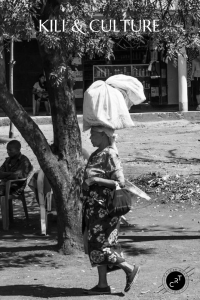
If you’re interested in learning more about photography (or cooking or film or any number of topics) check out MasterClass All-Access Pass for on-line excellence:

[et_bloom_inline optin_id=”optin_10″]
What is #CancerRoadTrip and how did it come to be? Read this post to get the backstory!
Follow me on Twitter, Pinterest, Instagram, and at Anti-Cancer Club. Connect with me! I may need a place or two to stay along the way!
Follow my blog with Bloglovin
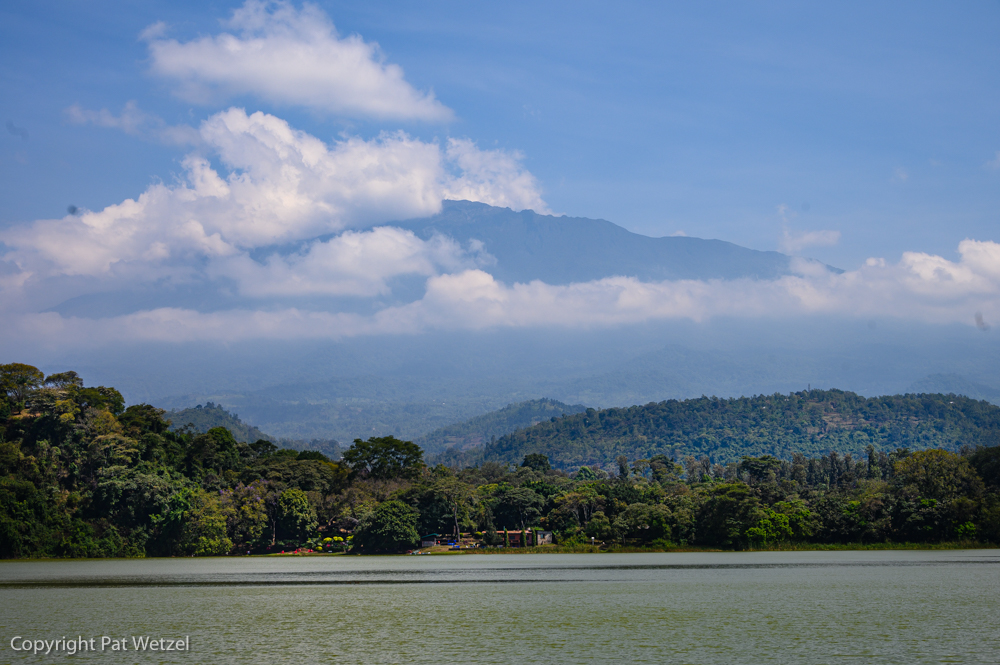
by Pat Wetzel | Oct 25, 2019 | Road Trip, The Story
Day 1 in Tanzania
I woke to a misty morning filled with the sounds of birds. I pulled back the mosquito netting that wrapped around the sleeping area and opened to drapes to a spectacular garden panorama.
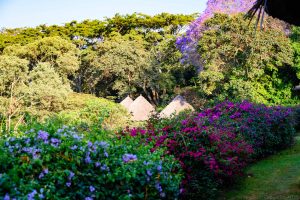
The morning view from my hut looks out on lush gardens and other huts nestled into the jungle.
Jacaranda, flowering shrubs and numerous trees flourish on the landscape. In the distance, Lake Duluti shimmers.
Each hut has a spectacular view and mine is breathtaking. I shrug off the fatigue of travel and consider breakfast up at the lodge.
The Serena Lodge in Arusha is a collection of beautifully appointed huts, nestled on acres of manicured grounds. The property has a vaguely British feel to it, with dark woods and white starched tablecloths in the dining room, and floral prints in the bar.
Breakfast is a daily buffet that includes fresh mango, passion and other juices; eggs prepared to your liking; breads and sweets; fresh fruit; cheese and meat; baked sweet potatoes and more.
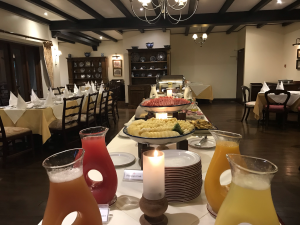
The breakfast buffet
And freshly dripped African coffee.
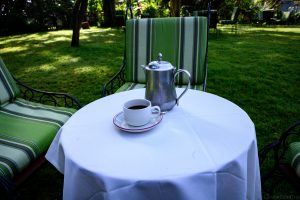
Rich, lush African coffee on the grassy patio
This is coffee as it should be. Each sip is rich with the essence of roasted beans. There is a body to the beverage–not a thickness but a sense of aromatic presence that translates into an almost savory, lingering flavor.
It is simply delicious. I could become a coffee drinker again.
Africa is a different place. It is simultaneously exotic, ordinary, lush, and lean. I was currently experiencing lush, although just a few miles outside the gated property, was lean.
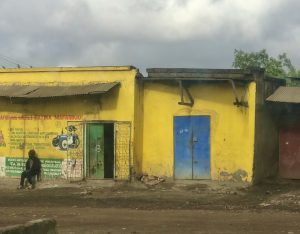
Local life is often very rudimentary
This disconnect, from the tourist experience to the local reality is one that I will witness throughout our trip. But people everywhere seem kind and helpful. The pace is relaxed.
Back at the hotel, echoes of British monarchy seemed to linger, in the language, in the food, and in the interior architecture of the Serena.
Which got me to wondering about the history of Tanzania.
A Short History of Tanzania: The Portuguese, The Germans and the British
The region that would become Tanzania was known as Tanganyika throughout its colonial history. It would not be until April 26 of 1964 that Tanganyika and Zanzibar would be united and the name Tanzania (a blend of Tanganyika an Zanzibar) became official.
Early western influence dates back to Vasco da Gama’s 1498 visit to the region. In 1505 the Portuguese capture of Zanzibar established trade.
In the early 18th century the Portuguese ceded control to Omani Sultan Seyyid Said who, with the assistance of the Omani Arabs, conquered Zanzibar in 1840 and made it the capital of the slave trade.

Originally discovered by the Portuguese, Tanzania would also interest the German and British.
German exploration in the mid nineteen century led to the discovery of Kilimanjaro by Johannes Rebman and brought railroad transportation and roads to the area. In 1885 the German East Africa Company took over the region, bringing railroads and roads.
The German defeat in World War I and the terms of the Treaty of Versailles then ceded the territory to the British.
World War II brought more western influence to the region. One hundred thousand natives fought for the Allied forces in Somaia, Abyssinia, Madagascar and in Burma. Food became an important export for Tanganyika during this period.
After the war, Tanganyika became a U.N. Trust Territory. But the gradual transition to independence was begun. The colonial officer David Gordon Hines was instrumental in helping to develop farming cooperatives that encouraged trade.
And in December of 1961 Tanganyika became independent from the British and all European rule.
Hiking Lake Duluti
Lake Duluti is a lake in Tengeru, on the eastern edge of the eastern branch of the Great Rift Valley. It was most likely formed when a volcano collapsed, leaving behind a small caldera that filled with water.
The lake lies just beyond the gates of the Arusha Serena. A hike seemed the perfect anecdote to over 30 hours of transcontinental travel.
A guide is required, as is signing in at the entry. Beyond that, the jungle envelopes you. You are now in its element and any notions of separation vanish. Animals move about; monkeys jump through the trees. Beautiful purple Jacaranda trees are interspersed along the lakeshore.
And in the distance, 14,980 foot tall Meru rises, overlooking it all.
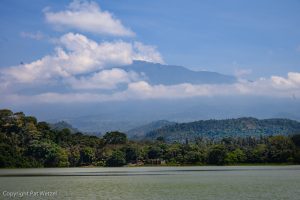
Meru looms over Lake Duluti
Meru isn’t as tall as nearby Kilimanjaro (19,341) but it is a more difficult and technical climb. While Kilimanjaro can be summited by most people in very good shape, Meru presents about 4,000 feet of technical climbing plus a 1,500 foot climb over nearly featureless granite.
But climbing is not on my agenda. A simple walk around Lake Duluti is.
Views from Lake Duluti
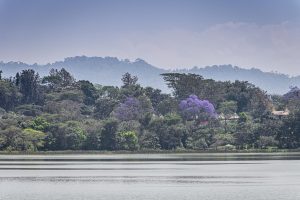
A view across Lake Duluti with purple flowering Jacaranda trees on the far shore
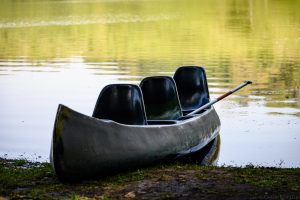
Canoe a trois
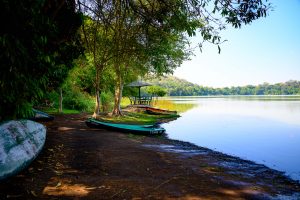
Looking down Lake Duluti
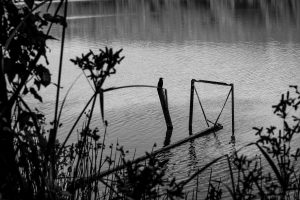
A bird resting lakeside
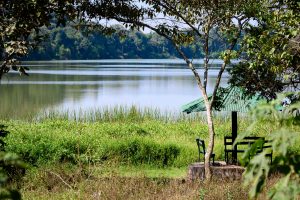
A seating area at the lake
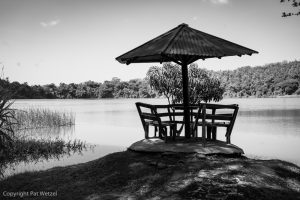
Picnic at Duluti anyone?
The hike around Lake Duluti is an easy one. After a day and a half of travel, this was exactly what I needed to start settling into Africa.
That and a glass of wine. As the evening approached, I approached the beautiful wood bar nestled in the corner of a room set with groupings of sofas and chairs, some in a floral print reminiscent of English chintz.
“Wine?” I inquired.
A nod and a smile from the bartender.
“What kind?” I asked, not sure how detailed to make my inquiry. Savignon Blanc, Chenin Blanc, Chardonnay?
“South African,” the bartender responded.
But of course.
And a well bodied and balanced Chenin blanc accompanied me out to the grassy patio overlooking the property.
As the sun sets, the air cools and the cicadas chirp. A Chinese group gather around one table, playing a ukulele. An Australian couple sits without speaking.
The wind moves. Every tree has its own dance. And with my first day in Africa, I start to settle in at 4,300 feet in the lush jungle.
More Reading On My African Safari
An African Photo Safari With A Nikon Ambassador
Safari Clothes: Packing for Safari
An African Photo Safari: Photo Equipment Packing List
Visas and Vaccinations for Tanzania
Like This Post? Pin It!

If you’re interested in learning more about photography (or cooking or film or any number of topics) check out MasterClass All-Access Pass for on-line excellence:
 [et_bloom_inline optin_id=”optin_10″]
[et_bloom_inline optin_id=”optin_10″]
What is #CancerRoadTrip and how did it come to be? Read this post to get the backstory!
Follow me on Twitter, Pinterest, Instagram, and at Anti-Cancer Club. Connect with me! I may need a place or two to stay along the way!
Follow my blog with Bloglovin
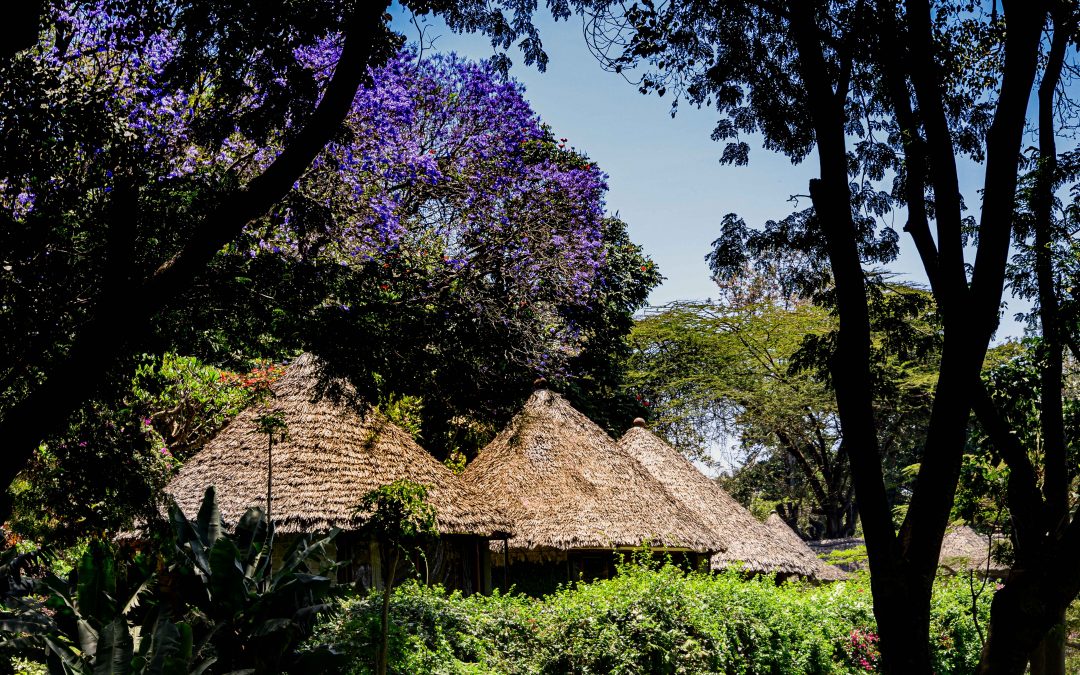
by Pat Wetzel | Oct 13, 2019 | Road Trip, The Story
An African photo safari with a Nikon Ambassador is both inspiring and humbling.
Kristi Odom is one of just 35 U.S. Nikon Ambassadors. The Ambassadors are selected by Nikon as some of the most influential photographers working today.
Kristi’s mission is to to:
“Show the beauty in the natural world and to connect people emotionally to wildlife. Also to inspire others to understand the power of photography and believe in themselves that they can make change.”
She has won over 60 international photography awards and her recent work has appeared in numerous places, including the Smithsonian. To say that I’m thrilled to be studying with someone of this calibre is an understatement.
I consider myself an advanced beginner when it comes to photography. And now I am about to embark on an African photo safari with 3 professional photographers.
Can anyone say out of my league?
I bought my first “real” camera just two years ago. It was a Nikon 5500 kit with two lenses. It sat in a travel bag by my side, ready to record my travels.
But I didn’t touch it for months.
Then one day on a Florida beach, I took some photos of sanderlings. The photos weren’t anything to write home about, but for me, at that stage of my experience, they opened my eyes to the potential of photography.

Sanderlings in Ft. Lauderdale, FL
And the idea that I could possibly create beautiful, and eventually, interesting images was born.
Now, two years later, I find myself stuck.
My beginner tricks are no longer working; my photographs lack a compelling message.
From a creative perspective, I can see images, but I can’t adequately express them. I need both technical knowledge and a more broad based education in what creates a compelling image.
Enter Kristi.
We met over a late breakfast on Canyon Road at the Teahouse in Santa Fe. She was in town for a visual storytelling class at Santa Fe Photo Workshops. (Yes, Nikon Ambassadors take classes, as well as giving talks, teaching and running trips like this one to Tanzania).
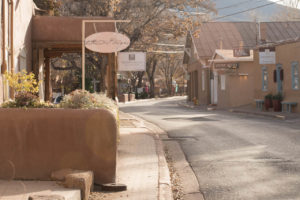
Canyon Road, Santa Fe
The prospect of visiting Tanzania was intriguing, but even more intriguing was a chance to study with Kristi. Her photos are captivating. And part of this trip included a year of one on one mentorship via Skype.
The chance to learn sold me. I was going to Tanzania.
Flight Path for An African Photo Safari
Getting to Tanzania meant thirty hours of travel for a total of 9,948 miles (each direction) in three legs: from Albuquerque to Atlanta; Atlanta to Amsterdam; and Amsterdam to Kilimanjaro.
Coming home, it was Kilimanjaro to Dar es Salaam, and then to Amsterdam, Atlanta and Albuquerque.
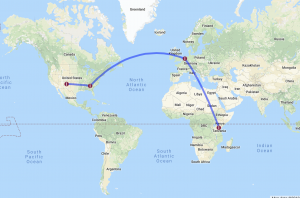
30 Hours To Tanzania
On the ground, our itinerary was equally ambitious, as we navigated parks, washboard dirt roads and wandering wildlife:
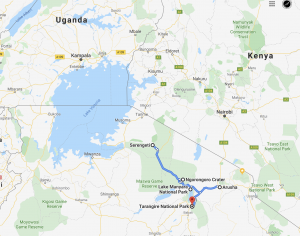
The travel route, over mostly unpaved, washboard roads that climbed thousands of feet, then dipped back down to vast savannas. Did I mention dust?
The Itinerary for a Tanzania Safari
I really had no idea what I was getting into (this is a theme that seems to repeat throughout my life and leads into the most interesting adventures).
Africa.
Ok, it would be fun to go to Africa.
A safari.
Why not?
So it was that I found myself in a rigorous schedule that started before daylight and often ended far after dark.
I am learning that photography trips can mean long days. But long days translate into photo opportunities that you’d otherwise miss. So, along with Kristi, our safari leader and Nikon Ambassador, and two other professional photographers, I set off for Tanzania.
Here is our itinerary:
Pre-Arrival, Two Days: I arrived late Saturday night. The following two days I hiked Lake Duluti and visited the foothills of Kilimanjaro.

A view across Lake Duluti
The formal safari itinerary:
African Photo Safari, Tanzania, Day 1: Arrival
African Photo Safari, Tanzania, Day 2: Arusha Cultural Heritage Center
The travelers–four of us including Kristi–met up for a morning of African art and history and an afternoon of education in the bar at the Arusha Serena Hotel.
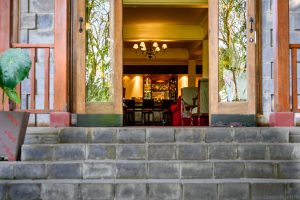
Entry to the bar at the Arusha Serena
African Photo Safari, Tanzania, Day 3: Arusha to Lake Manyara
This leg included a morning safari drive followed by one on one mentoring with Nikon Ambassador Kristi Odom while we stayed at the Lake Manyara Serena with spectacular views overlooking the lake.

Water buffalo at Lake Manyara
Click here for the Drive-By Gallery, a series of photos taken en route to Lake Manyara
Click here for photos and information on Lake Manyara.
African Photo Safari, Tanzania, Day 4: Lake Manyara to the Serengeti
A drive along an unpaved, washboard road up to the Ngorongoro Crater and then down into the Serengeti where we would spend two nights at the Serengeti Sopa Lodge. Our welcome to the Serengeti: A rather angry elephant that came right up to our vehicle!
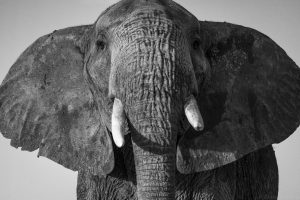
Welcome to the Serengeti!
Click here for a look at an amazing elephant family we encountered as we sped for the Serengeti.
African Photo Safari, Tanzania, Day 5 : Serengeti National Park
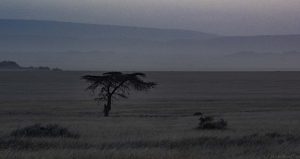
Evening falls on the Serengeti
African Photo Safari, Tanzania, Day 6: Serengeti National Park to the Ngorongoro Crater
We had a glimpse of the Crater from our trip to the Serengeti. This time it was a two night stay at the Sopa Lodge at the eastern edge of the Crater.
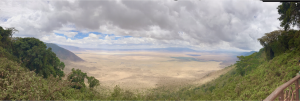
A panorama of Ngorongoro Crater
African Photo Safari, Tanzania, Day 7: Ngorongoro Crater
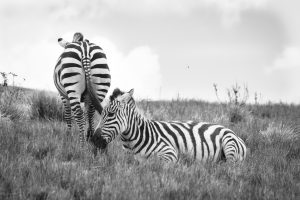
Black and white personified
African Photo Safari, Tanzania, Day 8: Ngorongoro Crater to Tarangire
We managed two game drives into this park before heading back to Kilimanjaro Airport.
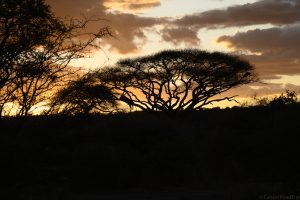
Lion in the tree at sunset
African Photo Safari, Tanzania, Day 9: Tarangire to Kilimanjaro Airport for an evening departure.
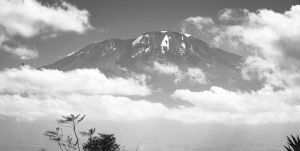
Kilimanjaro
I’ll be sharing the details of the safari in an upcoming series of posts over the next few weeks. I took about 10,000 photos and have a bit of editing to do! Stay tuned for some great adventures!
Traveling to Tanzania
I landed around 8 p.m. tired from 30 hours of transcontinental travel.
The entire plane disembarked into the Customs area, segregated into two groups: those with visas, and those without. Both lines were long and slow. Definitely get your visa ahead of time.
Just past customs, drivers await.
My driver, “Gift” (an English translation from his Swahili name), led me out into a dense and cool evening. The dirt parking lot was filled with safari vehicles. We set off, on the left hand side of the road, for the 45 minute trip to the Arusha Serena Hotel.
Saturday night in Africa is much like Saturday night anywhere. Along the road, in the dark, people meet and mingle. Occasional music and voices drifted through the open vehicle window.
I dozed, exhausted from travel. Even the swaying of the vehicle, bumping over rutted unpaved roads was not enough to wake me.
Until we arrived at the lodge.
Shimmering in the dark were massive trees, up lit by landscape lights. Piles of flowers spilled onto the grass. Chirping sounds suspended in silence filled the night.
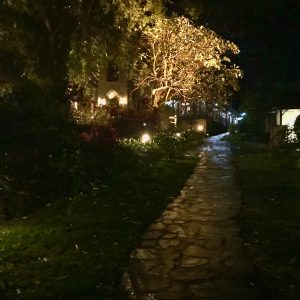
Trees glowed in the dark as I arrived at the Arusha Serena Lodge.
The kind staff led me to my hut, a beautiful room overlooking the flowering grounds and in the distance, Lake Duluti.
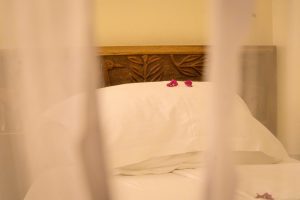
Flower petals scattered on the bed, behind a mosquito net
On the bed were scattered flower petals. And around the beds, a mosquito net was pulled shut. I quickly showered, parted the netting carefully, closing it behind me, and went to bed.
I had landed in Africa.
More Reading on An African Photo Safari
Safari Clothes: Packing for Safari
An African Photo Safari: Photo Equipment Packing List
Visas and Vaccinations for Tanzania
Like This Post? Pin It!
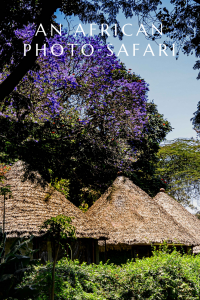
If you’re interested in learning more about photography (or cooking or film or any number of topics) check out MasterClass All-Access Pass for on-line excellence:

[et_bloom_inline optin_id=”optin_10″]
What is #CancerRoadTrip and how did it come to be? Read this post to get the backstory!
Follow me on Twitter, Pinterest, Instagram, and at Anti-Cancer Club. Connect with me! I may need a place or two to stay along the way!
Follow my blog with Bloglovin







 [et_bloom_inline optin_id=”optin_10″]
[et_bloom_inline optin_id=”optin_10″]


















































